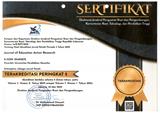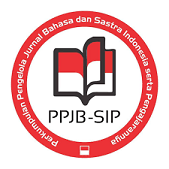STRATEGI PEMBELAJARAN MENYENANGKAN DENGAN HUMOR DALAM PEMBELAJARAN BAHASA INDONESIA DI KELAS X SMA NEGERI 2 MENDOYO
DOI:
https://doi.org/10.23887/jjpbs.v3i1.5300Abstrak
Penelitian deskriptif kualitatif ini bertujuan mendeskripsikan (1) perencanaan strategi pembelajaran menyenangkan dengan humor di kelas X SMA Negeri 2 Mendoyo, (2) pelaksanaan strategi pembelajaran menyenangkan dengan humor di kelas X SMA Negeri 2 Mendoyo, dan (3) kendala-kendala guru dalam menggunakan strategi pembelajaran menyenangkan dengan humor di kelas X SMA Negeri 2 Mendoyo. Subjek penelitian ini adalah guru mata pelajaran Bahasa Indonesia di kelas X SMA Negeri 2 Mendoyo dengan objek penelitian yakni strategi pembelajaran menyenangkan dengan humor. Ada tiga metode yang digunakan dalam penelitian ini yakni, metode wawancara, observasi, dan dokumentasi. Hasil penelitian menunjukkan (1) guru telah merencanakan strategi pembelajaran menyenangkan dengan humor secara eksplisit di dalam RPP, (2) pelaksanaan strategi pembelajaran menyenangkan dengan humor telah berjalan dengan baik, dan (3) terdapat beberapa kendala yang dialami oleh guru dalam menggunakan strategi pembelajaran menyenangkan dengan humor, yaitu sulitnya mendapatkan sumber teori yang relevan, sulitnya menyesuaikan humor dengan kebutuhan siswa, dan sulitnya mendapatkan media humor sebagai bahan ajar. Penelitian ini hanya terbatas pada kajian perencanaan, pelaksanaan, dan kendala-kendala, disarankan bagi peneliti lain untuk melakukan pengujian lebih mendalam mengenai pengaruh humor terhadap hasil belajar siswa.Kata Kunci : strategi pembelajaran, humor
This descriptive qualitative study was aimed at describing (1) the planning of fun instructional strategy combined with humor in Class X of SMAN 2 Mendoyo, (2) the implementation of fun instructional strategy combined with humor in Class X of SMAN 2 Mendoyo and (3) the obstacles faced by the teacher in implementing fun instructional strategy combined with humor in Class X of SMAN 2 Mendoyo. The subject of the study was a teacher teaching Indonesian in Class X of SMAN 2 Mendoyo and the object of the study was fun instructional strategy combined with humor. There were three methods of data collection applied in the study, such as interview, observation and documentation. The result of the study revealed that (1) the teacher had put fun instructional strategy combined with humor in her instructional plan explicitly, (2) fun instructional strategy combined with humor could implemented perfectly, and (3) there were some obstacles faced by the teacher in implementing fun instructional strategy combined with humor, those, are the difficulty of finding relevant references, the difficulty of matching the humor with the students’ need and the difficulty of creating a humorous media as teaching material. This present study was limited at describing the planning of fun instructional strategy combined with humor, the implementation of fun instructional strategy combined with humor and the obstacles faced by the teacher in implementing fun instructional strategy combined with humor. Thus, it is suggested to other researchers to study the effects of humor toward students’ learning result.
keyword : fun instructional strategy, humor
Diterbitkan
2015-07-22
Terbitan
Bagian
Articles
Lisensi
Authors who publish with the Jurnal Pendidikan Bahasa dan Sastra Indonesia Undiksha agree to the following terms:- Authors retain copyright and grant the journal the right of first publication with the work simultaneously licensed under a Creative Commons Attribution License (CC BY-SA 4.0) that allows others to share the work with an acknowledgment of the work's authorship and initial publication in this journal
- Authors are able to enter into separate, additional contractual arrangements for the non-exclusive distribution of the journal's published version of the work (e.g., post it to an institutional repository or publish it in a book), with an acknowledgment of its initial publication in this journal.
- Authors are permitted and encouraged to post their work online (e.g., in institutional repositories or on their website) prior to and during the submission process, as it can lead to productive exchanges, as well as earlier and greater citation of published work. (See The Effect of Open Access)







